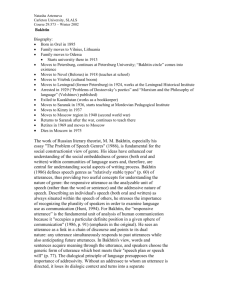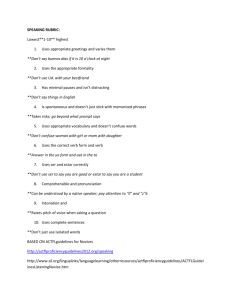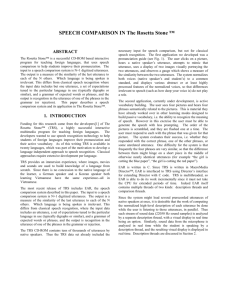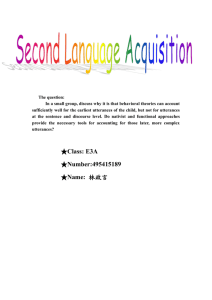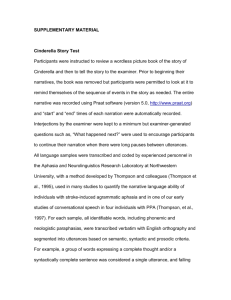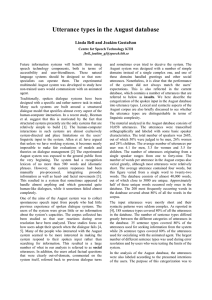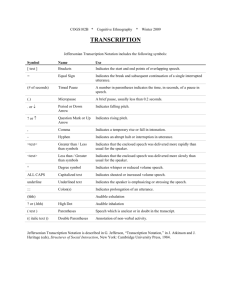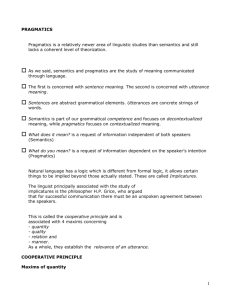Bakhtin, M - Sullivan Files
advertisement
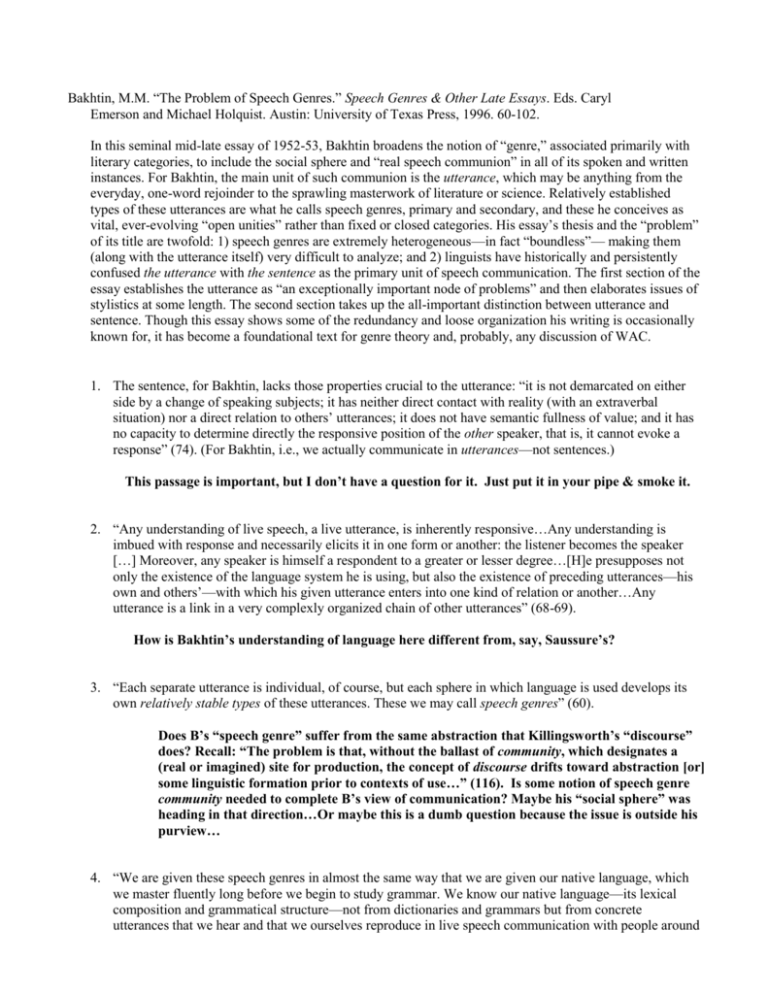
Bakhtin, M.M. “The Problem of Speech Genres.” Speech Genres & Other Late Essays. Eds. Caryl Emerson and Michael Holquist. Austin: University of Texas Press, 1996. 60-102. In this seminal mid-late essay of 1952-53, Bakhtin broadens the notion of “genre,” associated primarily with literary categories, to include the social sphere and “real speech communion” in all of its spoken and written instances. For Bakhtin, the main unit of such communion is the utterance, which may be anything from the everyday, one-word rejoinder to the sprawling masterwork of literature or science. Relatively established types of these utterances are what he calls speech genres, primary and secondary, and these he conceives as vital, ever-evolving “open unities” rather than fixed or closed categories. His essay’s thesis and the “problem” of its title are twofold: 1) speech genres are extremely heterogeneous—in fact “boundless”— making them (along with the utterance itself) very difficult to analyze; and 2) linguists have historically and persistently confused the utterance with the sentence as the primary unit of speech communication. The first section of the essay establishes the utterance as “an exceptionally important node of problems” and then elaborates issues of stylistics at some length. The second section takes up the all-important distinction between utterance and sentence. Though this essay shows some of the redundancy and loose organization his writing is occasionally known for, it has become a foundational text for genre theory and, probably, any discussion of WAC. 1. The sentence, for Bakhtin, lacks those properties crucial to the utterance: “it is not demarcated on either side by a change of speaking subjects; it has neither direct contact with reality (with an extraverbal situation) nor a direct relation to others’ utterances; it does not have semantic fullness of value; and it has no capacity to determine directly the responsive position of the other speaker, that is, it cannot evoke a response” (74). (For Bakhtin, i.e., we actually communicate in utterances—not sentences.) This passage is important, but I don’t have a question for it. Just put it in your pipe & smoke it. 2. “Any understanding of live speech, a live utterance, is inherently responsive…Any understanding is imbued with response and necessarily elicits it in one form or another: the listener becomes the speaker […] Moreover, any speaker is himself a respondent to a greater or lesser degree…[H]e presupposes not only the existence of the language system he is using, but also the existence of preceding utterances—his own and others’—with which his given utterance enters into one kind of relation or another…Any utterance is a link in a very complexly organized chain of other utterances” (68-69). How is Bakhtin’s understanding of language here different from, say, Saussure’s? 3. “Each separate utterance is individual, of course, but each sphere in which language is used develops its own relatively stable types of these utterances. These we may call speech genres” (60). Does B’s “speech genre” suffer from the same abstraction that Killingsworth’s “discourse” does? Recall: “The problem is that, without the ballast of community, which designates a (real or imagined) site for production, the concept of discourse drifts toward abstraction [or] some linguistic formation prior to contexts of use…” (116). Is some notion of speech genre community needed to complete B’s view of communication? Maybe his “social sphere” was heading in that direction…Or maybe this is a dumb question because the issue is outside his purview… 4. “We are given these speech genres in almost the same way that we are given our native language, which we master fluently long before we begin to study grammar. We know our native language—its lexical composition and grammatical structure—not from dictionaries and grammars but from concrete utterances that we hear and that we ourselves reproduce in live speech communication with people around us. We assimilate forms of language only in forms of utterances and in conjunction with these forms…” (78). Can the utterance, as defined, be taught? I.e., is it a useable category? Likewise for “speech genres”? How do we reconcile what is apparently a lived, absorptive, ongoing informal education in speech genres with our efforts at formalized instruction? (And the million$$$ question: how do we bring students of our vertical curriculum into the “live speech communication” of their chosen disciplines? Can we?) Is Ella in fact learning speech genres right now, rather than “words” or “sentences”? 5. “The “stylistic aura” belongs not to the word of language as such but to that genre in which the given word usually functions. It is an echo of the generic whole that resounds in the word…[O]ne can say that any word exists for the speaker in three aspects: as a neutral word of a language, belonging to nobody; as an other’s word, which belongs to another person and is filled with echoes of the other’s utterance; and, finally, as my word, for, since I am dealing with it in a particular situation, with a particular speech plan, it is already imbued with my expression” […] Our speech, that is, all our utterances (including creative works), is filled with others’ words, varying degrees of otherness or varying degrees of “our-ownness”…These words of others carry with them their own expression, their own evaluative tone, which we assimilate, rework, and re-accentuate” (88, 89). Bakhtin here adopts the metaphor of ownership in his examination of speech communication. What does it mean for a “word” to “belong” to someone? How might this tri-part notion of word ownership inform our understanding of student writers’ strengths and weaknesses? 6. “In each epoch, in each social circle, in each small world of family, friends, acquaintances, and comrades in which a human being grows and lives, there are always authoritative utterances that set the tone— artistic, scientific, and journalistic works on which one relies, to which one refers, which are cited, imitated, and followed. In each epoch, in all areas of life and activity, there are particular traditions that are expressed and retained in verbal vestments: in written works, in utterances, in sayings, and so forth” (88). What exactly constitutes an utterance’s “authority”? What are the authoritative utterances of English Studies? Of rhetoric, literature, or creative writing as fields? Of our own dept. in Minard Hall as well as in South Engineering? Of Old Main? [I almost typed “Old Man.”] How, if at all, are such utterances authorized, affirmed, challenged, subverted, or renewed? Is there such a thing as a truly dialogic classroom experience in an environment where grades are assigned? Is the “student-centered classroom” merely a pleasant illusion to avoid facing the real issues of power in our classes? Can I possibly pile any more probably unanswerable questions into this one last little rapidly evaporating space on the page? Final umbrella questions: What is at least one meaningful connection between “the myth of transience” and Bakhtin’s notions of utterance & sentence? How many Bakhtinians does it take to screw in a light bulb? I don’t know, but there’s got to be a good answer out there somewhere… 2
